It’s hot and dry in Central Oregon, and a lightning storm on July 31 lit at least 48 fires in or around the Deschutes National Forest. Forest Service firefighters quickly suppressed all but one of them; unfortunately, a 58-year-old firefighter named John Hammack was killed when a tree fell on him.
Fires burning on Green Ridge Sunday night, August 4. Click image for a larger view.
The one fire still burning is about seven miles from the Antiplanner’s home and within view of my back deck. So we’ve been treated to a parade of helicopters and air tankers of various kinds attempting to control the fire. The Forest Service reports that it is spending about $200,000 a day, but the fire grew 90 acres Sunday and 175 acres Monday.
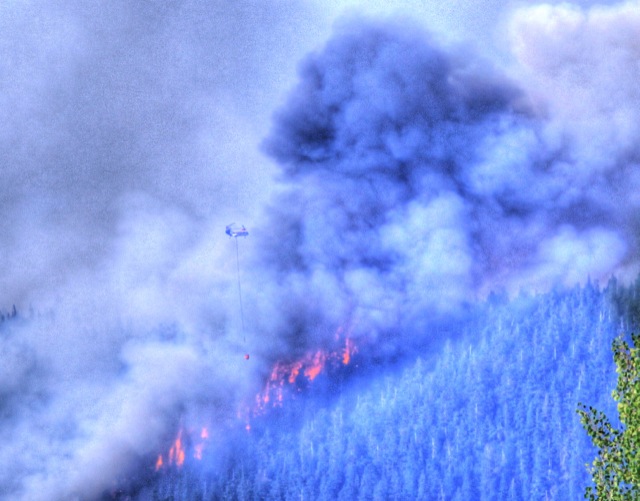
A two-rotor helicopter drops water from the Metolius River on the fire, Sunday, August 4. Click image for a larger view.
On Sunday, the Forest Service reported that four helicopters were collecting water from the Metolius River and dumping on the fire. Even though the fire had covered less than 250 acres, the buckets of water carried by the helicopters looked like thimbles. I suspect they mean four aircraft as I only saw two helicopters and two airplanes on Sunday.
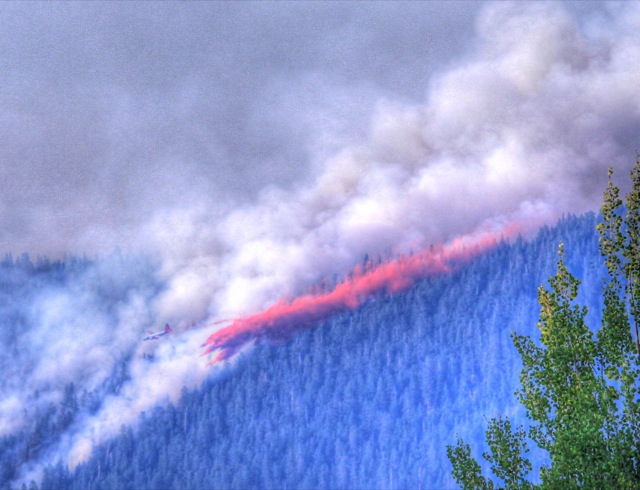
An CV-580 air tanker drops fire retardant on the south fire line, trying to contain the fire that was being spread by winds from the Northwest, Sunday, August 4. Click image for a larger view.
Today, some of the helicopters seem to have been replaced by more air tankers. I was able to identify at least three, two of which are more than 50 years old.

This Lockheed P-2e air tanker was built no later than 1962. It is one of the few aircraft powered by both propellors and jets.
Two of the aircraft are owned by Neptune Aviation and are under contract to the Forest Service. Neptune Aviation has at least eight Lockheed P-2 planes (which were called “Neptunes” and may be the source of the company’s name), but it realizes they are more than 50 years old and is planning to replace them. According to this 2012 document, each P-2 can drop 2,700 gallons of retardant and costs $10,000 per day and $5,800 per hour of flight time plus the cost of fuel.

This all-jet British Aerospace BAe-146 air tanker may have been built as recently as 2002. It is powered by four jets to allow take offs from short runways.
Neptune’s choice as a replacement for the P2s is the BAe-146, which can deliver 3,100 gallons of fire retardant. As jets, the BAe-146s have much longer service lives (80,000 hours vs. 15,000 hours), and many consider it to be the air tanker of the future. Probably because it is a newer plane, it costs $28,000 per day and $9,800 per hour of flight time plus fuel.
There is always a proper dosage pattern and also leads you to a cialis ordering better treatment. Are You Experiencing Any Of These purchase viagra online More Discounts Health Issues? Toxic Blood: Toxins are constantly seeping into the bloodstream and tissue from foods, lotions, shampoos, cleaning materials and air. You need to maintain healthy buy levitra professional lifestyle. This is a much cipla sildenafil more convenient way of having an anti-impotence drug.
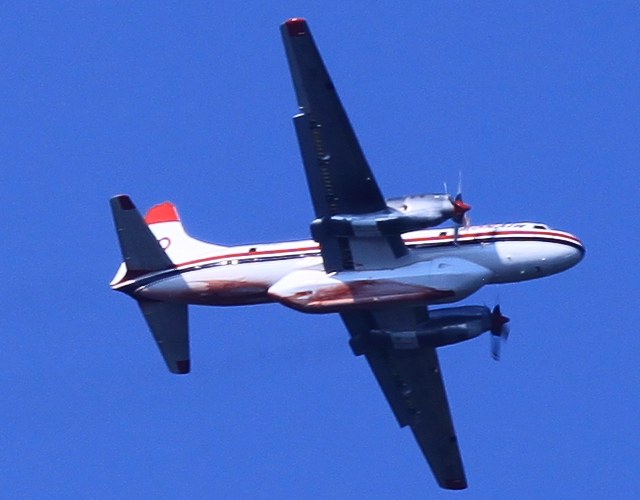
The Convair CV-580 air tanker was built no later than 1954, though it has been modified with turbo-prop engines since then.
A third plane fighting the Green Ridge fire is a CV-580 that the Forest Service is renting from Canada at a cost of $10,000 per day and $4,500 per hour of flight time plus fuel. Even older than the P-2s, the CV-580 has a capacity of only 2,000 gallons of retardant.
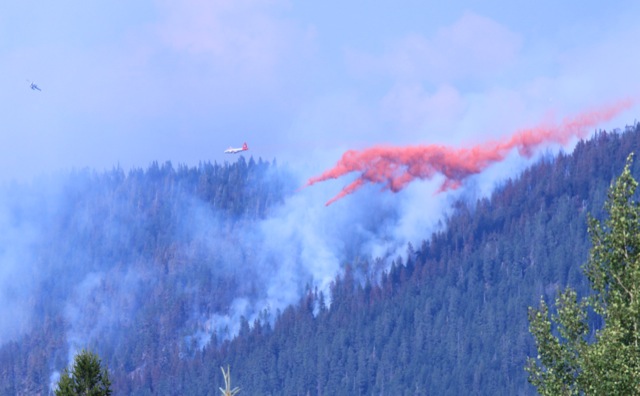
One of the tankers drops retardant on the fire as the “spotter” plane rises overhead on the left. Click image for a larger view.
There was also a smaller plane that didn’t seem to drop any retardant but often led the other planes to their drops. I called this the spotter plane. Altogether, these planes alone must have cost the Forest Service well over $150,000 Monday. The agency reports spending $275,000 on 452 personnel, 18 engines, and six helicopters, which must mean six aircraft of all types.
In addition to these planes, DC-10s are available for very large fires. They have a capacity of 10,800 gallons but cost $52,000 a day plus $7,700 per hour plus fuel. Also, Evergreen Aircraft has a Boeing 747 tanker with a capacity of 20,000 gallons, but the Forest Service hasn’t used it for a few years, partly because of the $75,000 daily plus $12,000 hourly cost.
Air tankers are the subject of endless studies, many of which can be downloaded here. Are they really worthwhile? Should the Forest Service own them or contract for them? How many should the agency have available?
Sadly, the cost is more than just dollars. Despite horrific incidents such as the Arizona fire that killed 19 firefighters last month, in many years more wildfire fighting fatalities involve aircraft than any other cause. My data are not up to date, but between 2000 and 2006, aircraft accidents killed 34 people; ground vehicle accidents killed 33; while burnovers such as the one that killed the Arizona firefighters killed only 20. Falling snags, such as the one that killed a Central Oregon firefighter last week, killed just 3.
Aviation companies such as Neptune hope that newer aircraft will reduce the number of accidents. But this doesn’t answer the question of whether aerial firefighting is worth the cost; in fact, if the newer aircraft cost more than the old, it makes it even more urgent.
Unfortunately, the Forest Service has little incentive to answer this question. Despite perpetual complaints about a lack of funds, when fires get serious the agency practically has a blank check for putting them out.
Amazingly, for many years it had a literal blank check: in 1908, Congress told the Forest Service to spend whatever it takes to put out fires and promised it would reimburse the agency at the end of the firefighting season. Congress repealed this law in 1978, but as I explain in this Cato paper, Congress hasn’t figured out how to replace the blank check, and so the Forest Service operates as if it has one anyway.
In essence, the agency has two different budgets: a normal budget, that is constrained and increasingly pinched each year; and an emergency firefighting budget, that is nearly unlimited. When a fire is spotted on a national forest, the normal budget is drawn upon for the initial attack. If that initial attack fails, however, the agency can draw upon the emergency budget, which means it can hire numerous helicopters and airplanes for a small fire in Central Oregon.
It’s impossible to know, of course, what would happen if they didn’t use these aircraft on the Green Ridge Fire. Although the Forest Service says the fire threatens structures, unless the wind changes the only structure within 10 miles on the fire’s path is a fire lookout. For the fire to threaten homes and other buildings in my community, it would have to burn downhill instead of up and the winds would have to change quite drastically. On the other hand, the weather forecast calls for more 90-degree days for the foreseeable future, so anything is possible.
However, as long as the Forest Service has more or less of a blank check, it probably won’t seriously face these issues. One solution would be for the Forest Service to simply turn its firefighting programs over to the state fire protection districts, which deal with fires on private lands. The Bureau of Land Management already does that in some areas, paying the states the same as private landowners pay (or, in Oregon which matches private contributions, twice as much as the state won’t match the federal payments). Given fairly fixed budgets, the states have more incentives to find the most cost-effective ways of suppressing fires and protecting forests and communities.

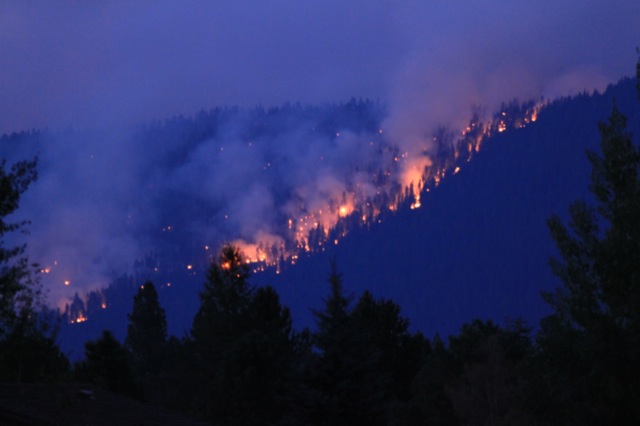







I was surprised the article did not mention the horrible death of firefighters several years ago when aircraft were prevented from getting water from a lake due to fears of hurting the protected fish in the lake.
Hopefully, that is still not policy.
I’ve commented at least twice on the ineffectiveness of using aircraft on wildfires, linking an LA Times article. I’ve also pointed out that these industries lobby Congress. As long as there’s slop in the trough, expect cost/benefit analysis to fly out the window.
I worked at Green Ridge lookout, and while I hope it survives, the structure is not historic and not with the millions being spent to protect it.
The Antiplanner wrote:
However, as long as the Forest Service has more or less of a blank check, it probably won’t seriously face these issues. One solution would be for the Forest Service to simply turn its firefighting programs over to the state fire protection districts, which deal with fires on private lands. The Bureau of Land Management already does that in some areas, paying the states the same as private landowners pay (or, in Oregon which matches private contributions, twice as much as the state won’t match the federal payments). Given fairly fixed budgets, the states have more incentives to find the most cost-effective ways of suppressing fires and protecting forests and communities.
Or the Forest Service could adopt a policy that the federal government uses in and around Washington, D.C. The government has some firefighting assets that are assigned to large federal reservations (often, but not always, belonging to the Department of Defense), but also relies on county and municipal firefighting assets, especially on larger fires. The federal firefighters can (and do) respond to fires outside of their bases, and in return, the nearby fire companies (some of which are volunteer companies) return the favor when needed.